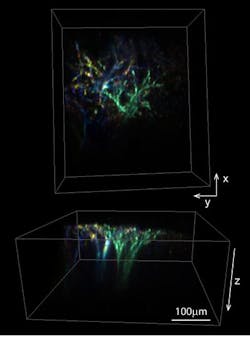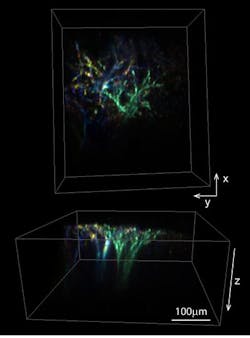Neuroscience trailblazer wins BRAIN Initiative grant for high-speed microscopy method
Elizabeth Hillman, associate professor of biomedical engineering at Columbia Engineering and of radiology at Columbia University Medical Center (CUMC; New York, NY), has received a National Institutes of Health (NIH) BRAIN Initiative grant, the first awarded to Columbia Engineering. The $1.83 million three-year grant, part of the White House's Brain Research through Advancing Innovative Neurotechnologies (BRAIN) Initiative, will support her work on a high-speed 3D microscopy method that she has developed for imaging the living brain.
Related: The BRAIN Initiative: Opportunities for optics and photonics
The method—called swept, confocally aligned planar excitation microscopy (SCAPE)—has surpassed a speed barrier that until now has stood in the way of neuroscience and biomedical discovery. Whereas most modern microscopes can only image a single plane at up to 20 frames/s, Hillman's technique can over 100 planes within a 3D volume in the same amount of time.
"With SCAPE, we can finally image neurons as they talk to each other within a large volume of the brain. In small animals such as zebrafish and fruit flies, we can image the entire nervous systems all at once," Hillman explains. "As these tiny animals are crawling, behaving, even making decisions, we can see their whole brain in action." In addition, she notes that SCAPE is easier to use, and simpler and cheaper to build than competing technologies, giving it great potential for widespread use across the life sciences.
Hillman has been developing SCAPE for the past seven years, but first published the technique in the journal Nature Photonics in February 2015. She has since been inundated with requests for systems, as well as collaborations, and is working hard to commercialize the technology.
Hillman's NIH BRAIN grant is one of five awarded this year for "Technologies for Large-Scale Recording-Modulation Optimization of Neural Activity." Sixty-seven new awards were made overall, totaling more than $38 million. These awards, the second wave of NIH grants to support the goals of the BRAIN Initiative, expand NIH's efforts to develop new tools and technologies to understand neural circuit function, and capture a dynamic view of the brain in action. The Initiative is part of a Presidential focus aimed at revolutionizing our understanding of the human brain.
Hillman's SCAPE technology is available for licensing from Columbia Technology Ventures.
Follow us on Twitter, 'like' us on Facebook, connect with us on Google+, and join our group on LinkedIn

